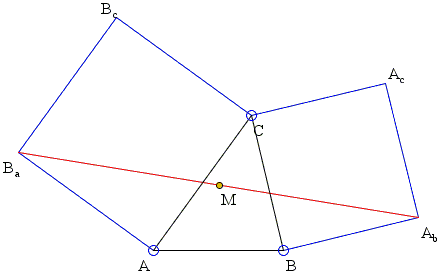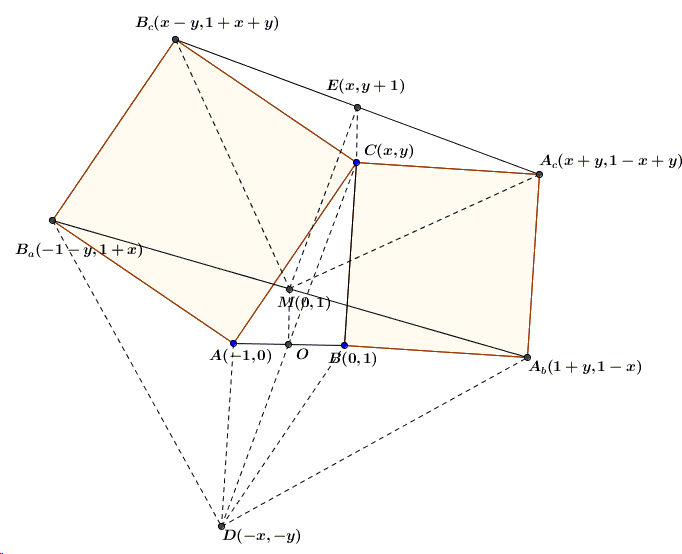Analytic Proof of Bottema's Theorem
Consider a configuration of two squares ACBcBa and BCAcAb with a common vertex C.

Bottema's theorem claims that the midpoint M of the segment AbBa is independent of C.
Proof
A short analytic proof by Hubert Shutrick demonstrates how simple the theorem actually is.
If \(A = (-1,0)\), \(B = (1,0)\) and \(C = (x,y)\), then \(A_b = (y+1, 1-x)\), \(B_a = (-1-y, 1+x)\) and their midpoint is \((A_{b} + B_{a})/2 = (0,1)\).
Moreover, the proof makes it rather obvious that the angle \(AMB\) is right and, therefore, is the center of the square erected on \(AB\) on the side of \(C\).
As a practice in analytic geometry we may elaborate on the above diagram:

As Hubert Shutrick has observed, \(\triangle A_{c}MB_{c}\) is right isosceles. He also noticed that \(OECM\), where \(E\) is the midpoint of \(A_{c}B_{c}\), is a parallelogram. Analytic geometry helps confirm another fact, the one noticed by William McWorter, viz., \(\triangle A_{b}B_{a}D\) is also right isosceles.
Bottema's Theorem
- Bottema's Theorem
- An Elementary Proof of Bottema's Theorem
- Bottema's Theorem - Proof Without Words
- On Bottema's Shoulders
- On Bottema's Shoulders II
- On Bottema's Shoulders with a Ladder
- Friendly Kiepert's Perspectors
- Bottema Shatters Japan's Seclusion
- Rotations in Disguise
- Four Hinged Squares
- Four Hinged Squares, Solution with Complex Numbers
- Pythagoras' from Bottema's
- A Degenerate Case of Bottema's Configuration
- Properties of Flank Triangles
- Analytic Proof of Bottema's Theorem
- Yet Another Generalization of Bottema's Theorem
- Bottema with a Product of Rotations
- Bottema with Similar Triangles
- Bottema in Three Rotations
- Bottema's Point Sibling
![]()
|Contact| |Front page| |Contents| |Geometry|
Copyright © 1996-2018 Alexander Bogomolny73500614
